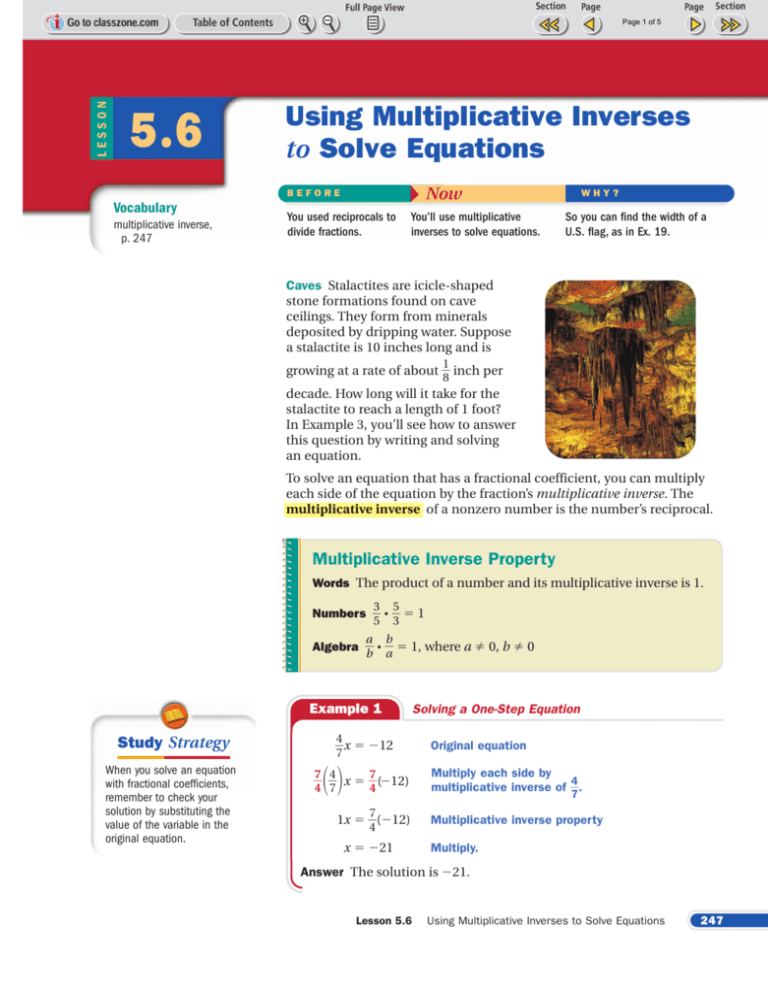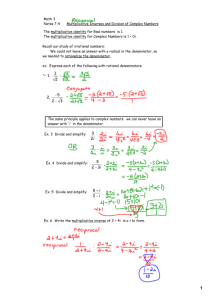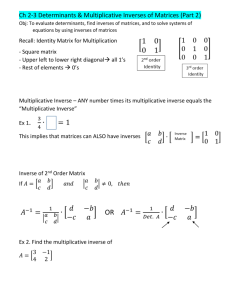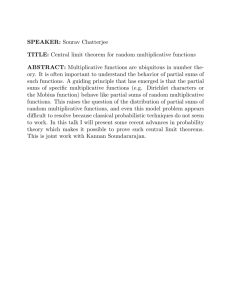Using Multiplicative Inverses to Solve Equations
advertisement

LESSON Page 1 of 5 5.6 Using Multiplicative Inverses to Solve Equations Now BEFORE Vocabulary multiplicative inverse, p. 247 You used reciprocals to divide fractions. You’ll use multiplicative inverses to solve equations. WHY? So you can find the width of a U.S. flag, as in Ex. 19. Caves Stalactites are icicle-shaped stone formations found on cave ceilings. They form from minerals deposited by dripping water. Suppose a stalactite is 10 inches long and is 1 8 growing at a rate of about inch per decade. How long will it take for the stalactite to reach a length of 1 foot? In Example 3, you’ll see how to answer this question by writing and solving an equation. To solve an equation that has a fractional coefficient, you can multiply each side of the equation by the fraction’s multiplicative inverse. The multiplicative inverse of a nonzero number is the number’s reciprocal. Multiplicative Inverse Property Words The product of a number and its multiplicative inverse is 1. 3 5 Numbers p 1 5 3 a b Algebra p 1, where a 0, b 0 b a Example 1 Study Strategy 4 x 12 7 When you solve an equation with fractional coefficients, remember to check your solution by substituting the value of the variable in the original equation. 7 4 7 x (12) 4 7 4 7 4 1x (12) x 21 Solving a One-Step Equation Original equation Multiply each side by 4 multiplicative inverse of . 7 Multiplicative inverse property Multiply. Answer The solution is 21. Lesson 5.6 Using Multiplicative Inverses to Solve Equations 247 Page 2 of 5 Example 2 11 15 Solving a Two-Step Equation 4 5 1 3 4 5 1 3 4 5 Subtract from each side. 11 15 1 3 4 5 Simplify. 11 15 5 15 x 11 15 4 5 Original equation 4 5 x x 12 15 x 11 15 7 15 1115 15 11 x 15 11 Write fractions using LCD. Subtract. 175 x 7 11 x Multiply each side by 11 multiplicative inverse of . 15 Multiply. Checkpoint Solve the equation. Check your solution. 5 1. m 20 6 3 2. 16 n 20 4 Example 3 2 1 5 3. p 3 2 6 Writing and Solving a Two-Step Equation Find how long it will take the stalactite described on page 247 to reach a length of 1 foot. Solution Write a verbal model. Let x represent the number of decades it will take the stalactite to reach a length of 1 foot. Current Number of New Growth length rate p decades length In the Real World Caves The photo above was taken in La Grotte de Gournier, a cave in France. Cave explorers have found that the deepest point in this cave is 680 meters beneath Earth’s surface. Give the depth of the cave in kilometers. Then use the fact that 1 km ≈ 0.62 mi to find the depth of the cave in miles. Is the cave more than or less than half a mile deep? 248 Chapter 5 1 8 10 x 12 Write equation. Write 1 foot as 12 inches. 1 8 Subtract 10 from each side. 10 x 10 12 10 1 x 2 8 18 8 x 8(2) x 16 Simplify. Multiply each side by 1 multiplicative inverse of . 8 Multiply. Answer The stalactite will be 1 foot long after 16 decades, or 160 years. Rational Numbers and Equations Page 3 of 5 5.6 Exercises INTERNET More Practice, p. 807 CLASSZONE.COM eWorkbook Plus Guided Practice Vocabulary Check 1. What is the multiplicative inverse of a nonzero number? 5 2 2. Describe how to solve the equation x . 6 7 Skill Check Guided Problem Solving Solve the equation. Check your solution. 4 3. x 16 9 7 4. x 28 12 2 6 5. x 3 7 1 6. x 5 11 3 7 7. x 9 5 8 3 3 27 8. x 4 8 32 9. Ants The diagram shows the distances of two ants from the edge of a picnic table. Ant A travels in a straight line at a speed 3 4 of inch per second. Ant B travels in a 7 8 straight line at a speed of inch per second. Table edge Ant A 10 12 in. Which ant will reach the edge first? 1 Use the formula distance rate time to write an equation for each ant. 2 Solve each equation from Step 1. 3 Compare your solutions to determine which ant will reach the edge first. Ant B 11 38 in. Practice and Problem Solving Homework Help Example 1 2 3 Exercises 11–20 21–29 30–31 10. Error Analysis Describe and 1 6 correct the error in solving the 1 6 2 3 x 2 3 equation x . 1 6 32 6 x 6 x4 Online Resources CLASSZONE.COM • More Examples • eTutorial Plus Solve the equation. Check your solution. 2 11. x 12 9 3 12. x 15 8 5 13. x 25 12 1 14. x 8 6 9 5 15. x 14 7 8 2 16. x 15 5 4 17 17. x 11 22 10 2 18. x 21 3 Lesson 5.6 Using Multiplicative Inverses to Solve Equations 249 Page 4 of 5 9 19. United States Flag The length of the United States flag is 1 times the 10 width of the flag. A particular U.S. flag is 5 feet long. Write and solve an equation to find the width of the flag. 20. Writing 3 7 Solve the equation x 5 by using a multiplicative inverse. 3 7 Then solve the equation by dividing each side of the equation by . Compare these two methods of solving the equation. How are they alike? How are they different? Solve the equation. Check your solution. 4 21. x 7 31 9 7 22. x (17) 4 11 3 23. 4 x 16 5 2 8 4 24. x 13 13 13 8 5 11 25. x 17 17 17 13 7 1 26. x 15 9 5 5 5 2 27. x 1 14 42 7 9 7 1 28. x 10 8 8 5 5 5 29. x 48 16 6 30. Geometry The figure shown is composed of two rectangles. The area of the figure is 1 square inch. a. Find the area of the red rectangle. b. Write an expression for the area of the blue rectangle. 1 in. c. Write an equation relating the sum of the areas in parts (a) and (b) to the total area of the figure. Solve the equation to find the value of x. 34 in. 58 in. x 31. Panama Canal Locks on the Panama Canal are used to move a ship from a higher elevation to a lower elevation. When a ship enters a lock chamber on the canal, water is allowed to spill out of the lock chamber into the next lock chamber until the water levels in the two chambers are equal. Suppose the water level in one lock chamber is 72 feet. As water spills out of the chamber, the depth changes at a rate of about 1 2 3 feet per minute until the water level is 41 feet. How many minutes does it take for the depth to change from 72 feet to 41 feet? 4 32. Baseball Game At a college baseball game, of the spectators are 5 In the Real World Panama Canal In the year 2002, 390 general cargo ships traveled through the Panama Canal from the Atlantic Ocean to the Pacific Ocean. The number of general cargo ships was 6 less than 3 times the number of passenger ships. How many passenger ships passed from the Atlantic to the Pacific? 250 Chapter 5 home team fans. The rest of the spectators are opposing team fans. There are 750 opposing team fans. a. Find the fraction of spectators who are opposing team fans. b. Find the total number of spectators at the game. c. One third of the home team fans at the game attend the college. How many home team fans attend the college? 8 1 33. Critical Thinking Suppose you want to solve the equation 2 x 15 2 1 by using the multiplicative inverse of 2. What is the multiplicative 2 1 inverse of 2? 2 Rational Numbers and Equations Page 5 of 5 34. Challenge The following is based on a famous problem about Diophantus, a Greek mathematician from the third century B.C. Let x be the number of years Diophantus lived. Find how long he lived by using the following facts about him to write and solve an equation. Mixed Review Algebra Basics Solve the inequality. Graph your solution. (Lesson 3.6) 35. 17 2y > 11 36. 5x 23 < 12 37. 6z 13 ≤ 31 38. Commuting Of the 1458 students at school A, 324 students take the bus. Of the 2123 students at school B, 242 take the bus. At which school is the fraction of students who take the bus greater? (Lesson 5.1) Find the sum or difference. (Lesson 5.3) 1 3 39. 3 4 Standardized Test Practice 1 5 40. 6 8 7 4 41. 12 9 9 3 42. 14 7 7 1 43. Multiple Choice What is the solution of the equation x 5 7 ? 12 3 13 1 C. D. 4 A. 4 B. 1 36 4 44. Short Response Two thirds of the lockers at a health club are rented to members at a rate of $6 per month. The other 48 lockers are available free to members on a first-come, first-serve basis. How much money does the club make from renting lockers each month? CD Sort 2 3 Your friend has a collection of CDs: of the 1 2 CDs have booklets, of the CDs are singles, and 1 are singles with booklets. All but two of the CDs are 4 either singles or have booklets or both. How many CDs does your friend have? Lesson 5.6 Using Multiplicative Inverses to Solve Equations 251









